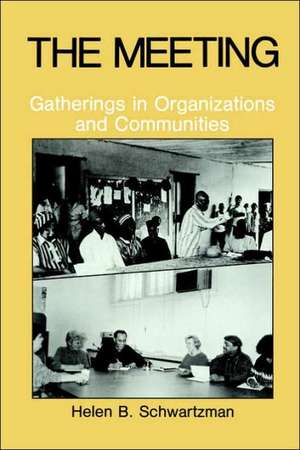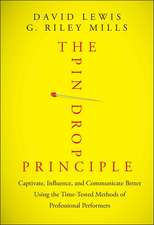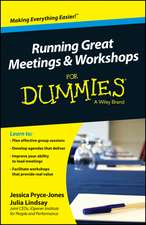The Meeting: Gatherings in Organizations and Communities
Autor H.B. Schwartzmanen Limba Engleză Hardback – 30 mai 1989
| Toate formatele și edițiile | Preț | Express |
|---|---|---|
| Paperback (1) | 947.67 lei 6-8 săpt. | |
| Springer Us – 30 mai 2013 | 947.67 lei 6-8 săpt. | |
| Hardback (1) | 953.20 lei 6-8 săpt. | |
| Springer Us – 30 mai 1989 | 953.20 lei 6-8 săpt. |
Preț: 953.20 lei
Preț vechi: 1162.43 lei
-18% Nou
Puncte Express: 1430
Preț estimativ în valută:
182.42€ • 188.45$ • 151.82£
182.42€ • 188.45$ • 151.82£
Carte tipărită la comandă
Livrare economică 26 martie-09 aprilie
Preluare comenzi: 021 569.72.76
Specificații
ISBN-13: 9780306431333
ISBN-10: 0306431335
Pagini: 344
Ilustrații: XVI, 344 p.
Dimensiuni: 155 x 235 x 21 mm
Greutate: 0.67 kg
Ediția:1989
Editura: Springer Us
Colecția Springer
Locul publicării:New York, NY, United States
ISBN-10: 0306431335
Pagini: 344
Ilustrații: XVI, 344 p.
Dimensiuni: 155 x 235 x 21 mm
Greutate: 0.67 kg
Ediția:1989
Editura: Springer Us
Colecția Springer
Locul publicării:New York, NY, United States
Public țintă
ResearchDescriere
In writing this book I discovered that everyone I talked to had his or her own theory about meetings, and yet there is no theory of meetings in the research literature. This makes writing about this subject both excit ing and hazardous. It is always exciting to examine the significance of something that has been ignored, but it is hazardous to write about something that everyone already thinks they understand. Without re course to the legitimacy of a research tradition, readers are likely to evaluate this study based on their own theory. I have tried to take this into account by discussing what might be referred to as American folk theory about meetings (see particularly Chapter 3), and also by juxtapos ing my own research in an American organization with research in traditional or non-Western societies as conducted by anthropologists. This juxtaposition throws into relief some of the important differences as well as similarities in views of meetings as well as the form of meetings across cultures. It is also the only way that I know to examine how and when one's cultural context is affecting one's theoretical constructions. If this book is successful, it will challenge what I believe is the most common interpretation of meetings found in American society, that is, that meetings are a blank-slate phenomenon useful as a tool for such functions as making decisions, solving problems, and resolving con flicts, but having no impact on behavior in and of themselves.
Cuprins
I. Meetings: The Issues and the Approach.- 1. Introduction.- 2. Occasions and Gatherings.- 3. Meetings as Tools/Meetings as Topics.- II. The Meeting: Gatherings in an American Organization.- 4. An Organized Anarchy.- 5. Constructing a Meeting.- 6. Meetings, Time, and Attention.- 7. History, Boundaries, and Ideological Conflict: The Council Meeting and the Training Meeting.- 8. Decisions and Power: The Committee Meeting and the Board Meeting.- 9. Expressions and Emotions: The Staff Meeting.- III. Meetings: Comparisons and Conclusions.- 10. Meetings, Culture, and Society.- 11. The Meeting: Foreground/Background.- Author Index.















